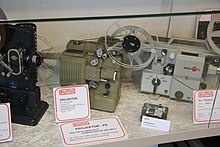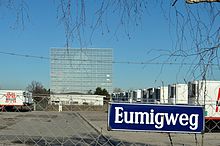Eumig
Eumig was an Austrian manufacturer of radios , film cameras and projectors , tape recorders and cassette decks .
history
Beginnings
In 1919 became the " E lektrizitäts- u nd M etallwaren- I ndustrie- G ompany mb H." in the left Wienzeile in 86 Wien-Mariahilf by Karl Vockenhuber, Alois Handler and Adolf Halpern, who brought most of the financial resources, founded. In the beginning, lighters were made from cartridge cases as well as cigarette boxes and various electrical materials. In the same year Eumig moved to Schallergasse 42 in 1120 Vienna.
In 1921 the company moved to Hirschengasse 5 in Mariahilf. Eumig now already had 65 employees.
Development of the later business area
In 1924 Eumig began producing radio equipment ("Low Loss Detector Receiver" and "Eumig Baby"). Company co-founder Adolf Halpern was paid out in 1926 and left the company.
In 1928 Eumig began developing film equipment. The first film projector for 16 mm film came in 1931: the "Eumig P 1". In 1932 the first film camera "Eumig C 1" for 9.5 mm film was presented. In 1935 Eumig brought out the film camera "Eumig C 2", also for 9.5 mm film. This was the first film camera in the world with semi-automatic tracking exposure control .
In 1935 Eumig acquired the Panradio company in Vienna X., Buchengasse 11-13. In 1937 the film cameras "Eumig C 3" (powered by a spring mechanism) and the "Eumig C 4" (powered by an electric motor) were released. A total of around 300,000 of the C-3 series were built. The C 4 was the world's first electric-powered amateur film camera.
From 1938 to 1945

After Austria's annexation in 1938, Eumig also manufactured its own radio models, Volksempfänger of the VE 301 dyn type and the German small receiver (DKE 38), and military devices during the war years. In 1941, Eumig had 1,000 employees. The Vienna plant in Buchengasse was damaged in 1945 by the air raids on Vienna . The machines had already been moved to a branch in Micheldorf the year before .
From 1945 to 1981
Karl Vockenhuber died in 1951, Alois Handler in 1960.
In 1951, Eumig tried his hand at cameras. The camera “Eumigetta” for roll film 6 × 6 cm was presented. Two years later the successor model "Eumigetta 2" appeared. Later the production of cameras was given up again. In 1954 Eumig presented the P 8 projector , the world's first home film projector with a low-voltage lighting system (12 volts).
In 1955, Eumig launched its most successful radio, the “Eumigette” (7 tubes for FM and MW). A total of around 500,000 pieces were produced. In 1956 a factory was built based on a design by Oswald Haerdtl at the Wiener Neudorf site. At the initiative of Karl Vockenhuber junior, after 6 weeks of testing and subsequent questioning of the workforce, Eumig was the first company in Austria to introduce the 40-hour week . In 1956, the C (amera) 16 for 16 mm film was introduced. In 1958 the company received the state award and was allowed to use the federal coat of arms in business dealings.
In 1961 Eumig had 3,000 employees. In 1962 radio production was given up and sold to HEA . In retrospect, Eumig has produced more than 3 million radios. The company then focused on building film cameras and projectors. The production was in Wiener Neudorf and Fürstenfeld .
In 1965, after Kodak (USA) had presented the Super-8 film, Eumig brought the film camera “Viennette Super-8” and the projectors “Mark M Super-8” with automatic threading and standstill projection and “Eumig Mark S Super-8” for Super 8 sound film on the market. At that time, Eumig was the only European manufacturer with a complete range of film equipment for Super 8 film. In 1969 Eumig took over the Swiss company Bolex . In 1971 Eumig introduced the “Mini” film camera. A total of around 500,000 pieces were produced from the mini series. In 1973 the silent film projector "Mark 610 D" (switchable for normal 8 and super 8 film) was brought onto the market. This projector was also sold in a similar form as the Bolex 18-3 Duo and the Revuelux 3003.
In 1974 the group management moved from the Wiener Buchengasse to the new high-rise next to the factory in Wiener Neudorf. In 1975 Eumig was the largest film projector manufacturer in the world (500,000 a year). Eumig had 5,000 employees. In 1976, a contract was signed with Polaroid (USA) to produce the Polavision instant film devices. The Polavision system consisted of the camera, the demonstration device and a film supplied in special cassettes, which could be developed immediately after exposure and shown after 90 seconds. Two years later, Eumig had to lay off 1,000 employees after Polaroid stopped working for Polavision. In 1977 Eumig tried again in the radio hi-fi industry and launched the 3-head hi-fi cassette deck "Metropolitan CCD", with built-in tuner and amplifier as "Metropolitan CC", in a desk design with fully electronic sensor control and optoelectronic synchronization control .
From 1978 a branch was established in Fohnsdorf for circuit boards and tool making .
In 1979 Eumig began developing a portable video recorder for the LVR system ( Longitudinal Video Recording , which was developed by BASF, recording was made in 48 parallel tracks). At the end of 1979, however, the further development of the LVR system was discontinued because the market opportunities were assessed as too small.
In 1979 the Eumig FL-1000uP cassette deck came out and replaced the Metropolitan series. It was controlled by a microprocessor ( Mostek MK 3870), had a front-loading drive that had been further developed by Metropolitan, in which the winding speed was electronically regulated during rewinding and thus had a very short rewind time, and thanks to an electronic counter it could precisely move to tape positions. Due to the flywheelless capstan drive, the ramp-up time was extremely short. The three heads were designed for pure iron strip. With the help of the built-in interface, up to sixteen decks could be controlled from one computer. The FL-1000uP won the “Award for Design and Engineering” of the Consumer Electronics Show (CES) in Chicago (USA) in 1979. In 1979 Eumig brought out the waterproof film camera “Nautica” for Super-8. It is suitable for a depth of up to 40 meters. In 1980 Eumig had 3,000 employees.
In 1980 Eumig presented the two film cameras "Eumig Sound 125 XL" and "Eumig Sound 128 XL" for Super 8 sound film. These were the only sound film cameras made by Eumig itself . Before that, Bell & Howell bought some sound film cameras .
Sudden end
In 1981 the development branch for surface-mounted electronic components (SMD) was sold to the Schrack company. The Österreichische Länderbank stopped the further financing of Eumig. The production of hi-fi devices has ended. In 1982 the former model company went bankrupt . The Eumig high-rise in Wiener Neudorf was sold to Palmers AG , the Eumig brand name to the Luxembourg company Interbasic . The Eumig patent for the macro system in the lenses was sold to the Japanese company Canon . The Fohnsdorf plant went to AT&S .
In July 1984 NORMA Messtechnik merged with OE (Optik, Elektronik & Metallwaren Industrie GmbH). The OE was the successor company of EUMIG, which is based in Wr. Neudorf had. Due to static problems at the NORMA headquarters, the entire staff moved to Wr. Neudorf.
In 1985 the EUMIG bankruptcy proceedings were concluded. In 1989 the German company Rothenberger GmbH, Frankfurt , acquired the rights to the name eumig , the company for the production of cameras and audio and video systems. Products for the sewer and pipe sector are sold under the name eumig industrie-tv GmbH Umwelttechnik , the company eumig industrie-tv Gesellschaft mb H. specializes in the SMD assembly of printed circuit boards.
Awards
- 1969 with Reinhold Zwerger: State Prize Design for Eumig Mark S-712 film projector
- 1973 with Reinhold Zwerger: State Prize Design for Video Camera Eumig 551
- 1975/76 with Reinhold Zwerger: State Design Award for the 800 series of cameras
Web links
- Website of the Eumig Museum sponsoring association to commemorate the history, products and social structure of the Eumig company. Retrieved January 27, 2015 .
- The Eumig Museum. Retrieved January 27, 2015 .
- The Eumig merger with NORMA. Retrieved October 21, 2015 .
- Eumig: The rise and fall of a company on ORF
- Radio news and articles about Eumig in the online archive of the Austrian Media Library (Ö1 journal articles)
Individual evidence
- ↑ a b Entry on Austria Technologie & Systemtechnik AG, AT & S in the Austria Forum (in the AEIOU Austria Lexicon )
- ↑ Outsourcing of circuit board production: Eumig-Boss fears negative consequences. ( Page no longer available , search in web archives ) Info: The link was automatically marked as defective. Please check the link according to the instructions and then remove this notice. In: Computerwoche. 8/1985. (on: computerwoche.de )
- ↑ eumig industrie-tv Gesellschaft mb H. Accessed January 27, 2015 .



